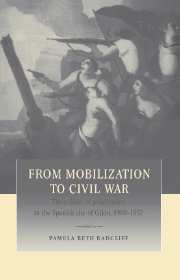Book contents
- Frontmatter
- Contents
- List of maps
- List of tables
- Acknowledgments
- Glossary of terms and abbreviations
- Introduction
- 1 A turning point: the city in 1900
- PART I Patterns of life in working-class Gijón
- 2 The structural context: economy, demography and urban space, 1900–1936
- 3 Culture and community in working-class Gijón
- PART II Institutional forces of opposition: republicans and anarchosyndicalists
- PART III Defining an oppositional culture: the struggle over the public sphere
- PART IV The urban battlefield: conflict and collective action, 1901–1936
- Conclusion
- Appendix 1 Wage and price movement
- Appendix 2 Occupations by status category
- Appendix 3 Supplementary tables
- Select bibliography
- Index
3 - Culture and community in working-class Gijón
Published online by Cambridge University Press: 31 October 2009
- Frontmatter
- Contents
- List of maps
- List of tables
- Acknowledgments
- Glossary of terms and abbreviations
- Introduction
- 1 A turning point: the city in 1900
- PART I Patterns of life in working-class Gijón
- 2 The structural context: economy, demography and urban space, 1900–1936
- 3 Culture and community in working-class Gijón
- PART II Institutional forces of opposition: republicans and anarchosyndicalists
- PART III Defining an oppositional culture: the struggle over the public sphere
- PART IV The urban battlefield: conflict and collective action, 1901–1936
- Conclusion
- Appendix 1 Wage and price movement
- Appendix 2 Occupations by status category
- Appendix 3 Supplementary tables
- Select bibliography
- Index
Summary
Within the demographic and structural context provided by an industrializing city, Gijón's working classes interpreted and shaped the contours of their everyday existence. These contours delineated the culture of working-class life in the city. This culture was characterized by a segregated sociability: a series of networks and linkages rooted in the social and residential gap between rich and poor residents of the city. These networks then formed the building blocks for a working-class community that could potentially unite the city's poorer residents. The community was not monolithic or static, as it was often divided by gender and by neighborhood. Nevertheless, when viewed from the outside, it was clear that the members of this community shared more than they differed in their way of life. On some basic level, the culture of working-class life gave the poorer residents of the city a common ground that set them apart from their wealthier counterparts. As a local teacher wrote in 1906, “Where can they meet each other in order to develop friendships and mutual respect? Not in school, nor in the street, in the workshop, the factory, in sum, nowhere.”
The common ground was both spatial and social, based, on the one hand, in residential segregation and, on the other, in activities that derived from one's social position in the city. Arguably, residential segregation had a greater impact on sociability in working-class neighborhoods, because wealthier residents had the mobility to establish long-distance ties. Thus, working-class networks were rooted more firmly in the neighborhoods in which they lived.
- Type
- Chapter
- Information
- From Mobilization to Civil WarThe Politics of Polarization in the Spanish City of Gijón, 1900–1937, pp. 87 - 114Publisher: Cambridge University PressPrint publication year: 1997

